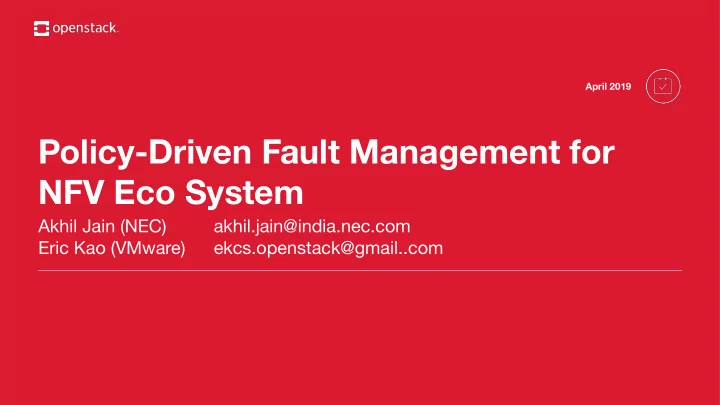

April 2019 Policy-Driven Fault Management for NFV Eco System Akhil Jain (NEC) akhil.jain@india.nec.com Eric Kao (VMware) ekcs.openstack@gmail..com
Definitions ● Network Function (NF): A functional building block in a network ○ packet inspection, CDNs, virus scanner, ... ● Network Function Virtualization (NFV): Realizing NFs as virtual appliances ● Virtual Network Function (VNF): A network function realized as virtual appliances
Fault Management ● Basic fault recovery is standard ● Complexities beyond the stardard cases: ○ Diversity of fault scenarios ○ Diversity of VNFs ○ Each combination may call for a different fault management response
Fault Scenarios ● Sequence of fault signals over time ● Isolated vs widespread ● Existing or predicted ● Fault types ○ Hard failure ○ Stability ○ Degraded performance ● Fault domains ○ Networking, Host, Storage, Application, etc
Context ● Current & anticipated loads ● VNF capacity ● Physical infra capacity ● Example considerations: ○ If load << VNF capacity, ignore certain fault prediction signals ○ If load ~= VNF capacity, preemptively scale-out ■ When physical infra limited, may need to scale-in a less loaded or less critical VNF to make room
VNF characteristics ● Stateful vs stateless ● Monolithic vs microservices ● Interactions, topology, service function chaining ● SLAs ● Business/user impact
Solution: Policy-driven fault management ● Fine-grained monitoring & alarming ○ Monasca, Prometheus, ... ● Rich Context ○ Infra managers: Nova, Kubernetes, … ○ NFV orchestrator: Tacker, ONAP, ... ○ application-level statistics: load, latency, throughput ○ Arbitrary data sources ● Expressive policy framework ○ Congress
webhook action Infra Alarm Services Managers Congress Policy Service data action Contextual Orchestrators Data Fault Management Policies
Congress Architecture ● Data ○ Get data from webhooks and APIs ○ Store data as tables and JSON ● Policy ○ Datalog/SQL rules transform data into decisions ● Action ○ Decisions can trigger API calls
Advantages ● Extensible ○ Arbitrary sources of data as needed by use case ● Expressive ○ Not limited by fixed vocabulary or set of properties ● Declarative ○ Well understood declarative language for expressing clear and manageable policies ○ Avoid procedural code
Example: preemptive scale out policy ● Predictive fault signal ● Possible response: ○ Ignore ■ failure occur ■ instances go down ■ load increases ■ autoscaling policy adjusts ● Drawback: ○ Degraded service for a time
Example: preemptive scale out policy ● Estimate service disruption/degradation ● Preemptively scale out as appropriate ● Minimize risk of degraded service
Example: preemptive scale out policy Alarms on hosts Instances data
Example: preemptive scale out policy Alarms on hosts Instances affected Instances data
Example: preemptive scale out policy Alarms on hosts Instances affected Instances VNFs data affected VNFs data
Example: preemptive scale out policy Alarms on hosts Instances affected Instances VNFs data affected VNFs predicted data load VNFs load data
Example: preemptive scale out policy Alarms on hosts Instances affected Instances VNFs data affected VNFs predicted scale out data load decisions VNFs load data
Example: preemptive scale out policy Alarms on hosts Instances affected Instances data instances_affected (instance_id) :- hosts_alarmed (alarmed_host), nova:servers (server_id=instance_id, host_name=alarmed_host)
Example: preemptive scale out policy predicted scale out load decisions scale_out (vnf_id) :- predicted_VNF_load (vnf_id, predicted_load), predicted_load > 0.9
Demo background ● Demonstrate the interaction between services ○ Setup VNFs with Tacker ○ Configure Congress to receive Monasca webhook ○ Configure Monasca to send webhook ○ Raise Monasca Alarm ○ See result of actions triggered by Congress policy
Summary ● Fault management is complex ○ Diversity of scenarios -> Diversity of response ● Solution ○ Fine-grained monitoring ○ Contextual data ○ Expressive policy ● Congress ○ Pluggable data sources ○ Expressive policy language ○ Triggers API calls
General purpose policy triggers ● Trigger API calls based on policy+data ○ Adv. fault management policies ○ Adv. autoscaling policies ○ Generic integration glue
Feedback welcome! Mailing lists use [congress] prefix openstack-discuss@lists.openstack.org Eric Kao <ekcs.openstack@gmail.com>
Akhil Jain <akhil.jain@india.nec.com> Q&A Eric Kao <ekcs.openstack@gmail.com> Thank you! openstack @OpenStack openstack OpenStackFoundation
Conceptual policy dataflow Alarms Technical Business Data Impact Impact Fault VNFs Biz Topology Mgmt Fault Data Decisions Mgmt Feasibility VNFs & Risks Tech Data
Recommend
More recommend